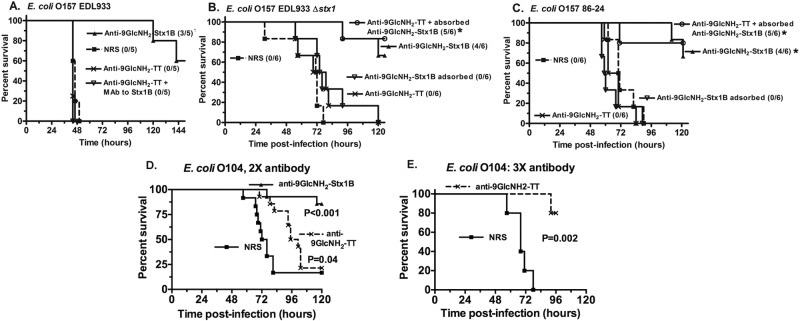FIG 5 .
Protection against E. coli O157 but not O104 requires both antibody to PNAG and Stx. (A) Five-day-old mice challenged with 5 × 108 CFU of E. coli EDL933 by oral gavage were protected following intraperitoneal (i.p.) injection of antibody to 9GlcNH2-Stx1b, but protection could not be achieved with antibody to a different PNAG oligosaccharide conjugate vaccine, 9GlcNH2-TT. Adding a monoclonal antibody to Stx1 to the PNAG-only antibody (9GlcNH2-TT) did not achieve protection. (B and C) Protection against E. coli O157 EDL933 Δstx1 (B) and 86-24 (C) obtained with antibody to 9GlcNH2-Stx1b was lost after absorption (9GlcNH2-Stx1b absorbed) with S. aureus MN8M to remove antibody to PNAG. Similarly, there was no protection after administering antibody to PNAG only (anti-9GlcNH2-TT). Addition of antibody to 9GlcNH2-Stx1b absorbed with S. aureus MN8M to the PNAG-only antiserum 9GlcNH2-TT restored protective efficacy, indicating that antibodies to both PNAG and Stx are required for protection. Kaplan-Meier survival curves were analyzed by log rank tests. An asterisk indicates an P value of <0.01 compared to survival in mice given NRS. (D) Survival of infant mice (12 to 14 mice/group; results from two identical experiments combined) challenged orally after two injections of the indicated antiserum (2X antibody) 16 and 4 h before infection. (E) Survival of infant mice (5 mice/group) injected with antisera raised to 9GlcNH2-TT given 3 times at 16 h before infection and at 24 and 48 h postinfection. The survival curves were analyzed by log rank test.

